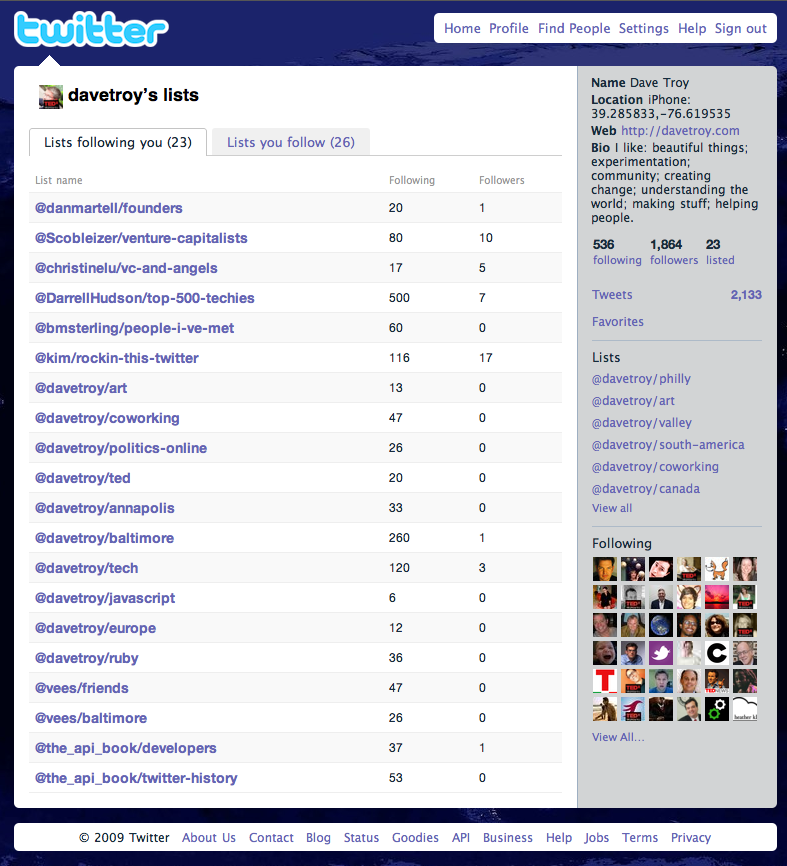I typically hate writing about topical technology subjects, because most often it’s reactive, worthless speculation.
However, the new Twitter “Lists” feature has me thinking; this is an interesting feature not because of the “tech” but because of the implications on the developing economics of social networks.
First, what it is: Twitter “Lists” allows you to create lists of Twitter users that are stored within Twitter’s servers. You can name those lists (/twitter.com/davetroy/art) and those URL’s can either be public or private.
People can then follow those lists, which really is more like “bookmarking” them, as they do not appear in your Twitter stream. Those lists in turn keep track of how many “followers” they have, and you can see how many people “follow” the lists you create.
Traditional “Follower Economics” Are Dead
Jack Dorsey and Biz Stone always said that the best way to get real value out of Twitter was to follow a small number of people; it was never their intention for people to aim to follow more than 150-200 people (the “Dunbar number,” or people we can realistically expect to maintain relationships with).
With “Lists” you can add someone to a list, but not necessarily “follow” them. So, instead of “following” Ashton Kutcher, you can put him in a list that you call “actors,” or “attention whores.”
You can even put someone in a list (cool people), have them publicize that, and then change the name of that list to something less flattering (douchebags, or worse).
The issue of derogatory lists alone is one that Twitter will need to address.
So traditional “follower counts” are going to be meaningless – instead of “followers” people are going to start talking about “direct followers,” “indirect followers,” and “being listed.” It’s all changing, and I applaud Twitter for being willing to throw the old (flawed) assumptions about follower economics entirely out the window in favor of a new approach.
Buying Influence and Reputation
Within a few hours of the introduction of “Lists” I was put onto a few:
- @danmartell/founders
- @Scobleizer/venture-capitalists
- @christinelu/vc-and-angels
- @DarrellHudson/top-500-techies
- @kim/rockin-this-twitter
- @the_api_book/twitter_history
This early “seed” of my reputation is quite flattering and arguably pretty powerful (though a fraction of what I expect my ultimate “listings” will be). It shows that I am an “investor” and a “techie,” and considered so by some pretty influential people. I did nothing to influence this and would not consider doing so.
But, I am lucky and glad to have been so-described this early on. What if I really wanted to influence what lists I was on, or to appear on as many lists as possible? I can imagine now the jockeying to get onto the lists of all the “A-List” digitalistas will be intense and powerfully ugly.
Imagine the seedy things that might go on at tradeshows in exchange for getting “listed.”
Going forward, the primary question will be which specific lists you appear on (influence of curator, quality, scarcity) and, secondarily, how many lists you appear on (reach, influence).
“1M Followers” will be replaced by “listed by over 50,000,” or even “listed by the top 10 most influential people in microfinance.” And yes, listing counts will be a fraction of follower count, as lists will necessarily divvy up the people you follow through categorization.
Scarcity: You get 20 lists
It looks like people are allowed just twenty lists right now. That’s undoubtedly a scaling and design decision by Twitter to keep things manageable.
Putting aside for a moment all the reasons why people might want more than 20 lists, let’s accept the limitation. You get 20 lists. So it’s a scarce resource. It means Scoble, Kawasaki, Gladwell, Brogan, Alyssa Milano, Oprah, Biz, etc, all each get just 20 lists.
What will someone pay to get onto one of these lists?
Do you think that an author would pay to get onto twitter.com/oprah/incredible-writers? Yeah, I do too. Now imagine that, writ large, and scummier, with people even less reputable than Oprah. Now you see what I’m talking about.
At least buying followers is a scummy behavior that’s amortized over millions of targets; buying 1/20th of one particular follower’s blessing could lead to very high prices and extremely unsavory dealings.
The Coming “Curatorial Economy”
Twitter is doing this thing, and whatever Twitter does in house trumps anything that a third party developer might do, period. So, stuff like WeFollow, etc, your brother’s cool thing he’s making, Twitter directories: they are done, people. Or these external things must at least accept the reality of Lists and what they mean to the ecosystem.
Some folks have been complaining about the user interface for list management, etc, and that’s all moot: it will be available through the API, and you should expect list cloning, lists of lists, mobile client support, etc, pretty soon.
But the genie is out of the bottle. Start managing your reputation in a way that’s authentic and ethical and stay on top of this. And be prepared for what I’m calling the “curatorial economy.” (You heard it here first.)
Everybody’s making collections, and there are certainly people who will pay and be paid for listings. Count on it.

